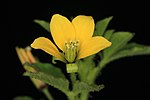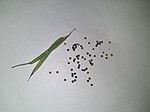Map Snapshot


5 Records
Status
"Naturalized from the Old World Tropics; Bermuda and West Indies" (Reed, 1964).
Seasonality Snapshot
No images available
Source: Wikipedia
| Cleome viscosa | |
|---|---|

| |

| |
| Scientific classification | |
| Kingdom: | Plantae |
| Clade: | Tracheophytes |
| Clade: | Angiosperms |
| Clade: | Eudicots |
| Clade: | Rosids |
| Order: | Brassicales |
| Family: | Cleomaceae |
| Genus: | Cleome |
| Species: | C. viscosa
|
| Binomial name | |
| Cleome viscosa | |
| Synonyms[1] | |
| |
Cleome viscosa, the Asian spiderflower[2] or tick weed[3] is an annual herb that grows up to a meter high. It belongs to the family Cleomaceae. It is considered an invasive species and is widely distributed in warm and humid habitats across the Americas, Africa and Asia,[4] and in Australia[5] (where it is considered a native).[6][7] It is commonly found during the rainy season.
The crushed leaves have been investigated as a treatment for stored seeds of cowpea, to prevent weevil infestation.[8]
The leaves are used as external application to wounds and ulcers. The seeds are anthelmintic and carminative. The juice of the leaves is used as a remedy against discharge of pus from the ear. In a study comparing C. viscosa to standard antibiotics, it was proven to be effective at inhibiting microbial growth. This demonstrates its effectiveness as an antimicrobial agent in comparison to the antibiotic tetracycline.[9]
In northern India, the seeds (called Jakhya) are used as a culinary herb, mainly for tempering. in Australia, the Walmajarri people of the southern Kimberley call it Jirlpirringarni.[10]
Description
[edit]Plants (10–)30–100(–160) cm. Stems viscid. Leaves: petiole 1.5–4.5(–8) cm, glandular-hirsute; leaflet blade ovate to oblanceolate-elliptic, (0.6–)2–6 × 0.5–3.5 cm, margins entire and glandular-ciliate, apex acute to obtuse, surfaces glandular-hirsute. Racemes 5–10 cm (10–15 cm in fruit); bracts (often deciduous), trifoliate, 10–25 mm, glandular-hirsute. Pedicels 6–30 mm, glandular-hirsute. Flowers: sepals green, lanceolate, 5–10 × 0.8–1.2 mm, glandular-hirsute; petals arranged in adaxial semicircle before anthesis, radially arranged at anthesis, bright yellow, sometimes purple basally, oblong to ovate, 7–14 × 3–4 mm; stamens dimorphic, 4–10 adaxial ones much shorter with swelling proximal to anthers, green, 5–9 mm; anthers 1.4–3 mm; ovary 6–10 mm, densely glandular; style 1–1.2 mm. Capsules dehiscing only partway from apex to base, 30–100 × 2–4 mm, glandular-hirsute. Seeds light brown, 1.2–1.8 × 1–1.2 mm, finely ridged transversely. 2n = 20.
Phenology
[edit]June–August (summer)
Taxonomy
[edit]The species was first described as Cleome viscosa in 1753 by Carl Linnaeus[11][12] This name is not accepted by the Western Australian Herbarium.[13] In Western Australia the accepted name is Arivela viscosa (L.) Raf.,[14] the name given to it in 1838 by Constantine Samuel Rafinesque[15] for the phylogenetic reasons given by Russell Barrett and others in 2017.[16]
Gallery
[edit]-
Cleome viscosa
-
Leaf of Cleome viscosa
-
Flower buds and Fruits of Cleome viscosa
-
Flower of Cleome viscosa
-
Flower of Cleome viscosa
-
Seeds of Cleome viscosa
References
[edit]- ^ The Plant List: A Working List of All Plant Species, retrieved 17 May 2016
- ^ NRCS. "Cleome viscosa". PLANTS Database. United States Department of Agriculture (USDA). Retrieved 21 October 2015.
- ^ "Cleome viscosa". FloraBase. Western Australian Government Department of Biodiversity, Conservation and Attractions.
- ^ "Cleome viscosa (Asian spiderflower)". www.cabi.org. Retrieved 2020-03-05.
- ^ "Cleome viscosa L." www.gbif.org. Retrieved 2021-11-07.
- ^ "Arviela viscosa (L.) Raf". FloraBase. Western Australian Government Department of Biodiversity, Conservation and Attractions. Retrieved 2021-11-08.
- ^ H.J. Hewson (2020). "Cleome viscosa". Flora of Australia. Canberra: Australian Biological Resources Study, Department of Agriculture, Water and the Environment. Retrieved 8 November 2021.
- ^ Dabire, C.L.B.; Niango Ba, M.; Sanon, A. (2008), "Effects of crushed fresh Cleome viscosa L. (Capparaceae) plants on the cowpea storage pest, Callosobruchus maculatus Fab. (Coleoptera: Bruchidae)", International Journal of Pest Management, 54 (4): 319–326, doi:10.1080/09670870802266953, S2CID 84117017
- ^ "Antimicrobial Effects of Cleome Viscosa and Trigonella Foenum Graecum Seed Extracts" (PDF). Journal of Cell and Tissue Research. 8 (2). 3 February 2008.
- ^ Bessie Doonday; Charmia Samuels; Evelyn (Martha) Clancy; et al. (2013). "Walmajarri plants and animals". Northern Territory Botanical Bulletin. 42: 92. Wikidata Q106088428.
- ^ "Cleome viscosa". Australian Plant Name Index, IBIS database. Centre for Plant Biodiversity Research, Australian Government. Retrieved 2020-12-30.
- ^ Linnaeus, C. (1753). "Tetradynamia Siliquasa". Species Plantarum. 2: 672.
- ^ "Cleome viscosa". FloraBase. Western Australian Government Department of Biodiversity, Conservation and Attractions.
- ^ "Name currency Cleome viscosa".
- ^ Rafinesque, C.S. (1838). Sylva Telluriana. p. 110.
- ^ Russell L. Barrett; Eric H. Roalson; Kym Ottewell; Margaret Byrne; et al. (27 December 2017). "Resolving Generic Boundaries in Indian‐Australasian Cleomaceae: Circumscription of Areocleome, Arivela, and Corynandra as Distinct Genera". Systematic Botany. 42 (4): 705. doi:10.1600/036364417X696401. ISSN 0363-6445. Wikidata Q93469797.






